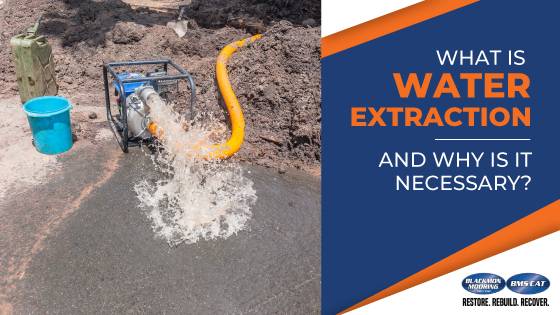Why is Water Extraction Important?
Water can cause extensive damage to a home, including mold growth, and structural damage. It is important to remove all water from a home as soon as possible to prevent further damage.
If water is not extracted from a home properly, it can cause a number of problems. These problems include:
- Mold growth
- Structural damage
- Insect and rodent infestation
- Health problems for the occupants of the home
To help you with this problem, we’ve included the best water extraction steps below.


Water Extraction Steps
After a flood, burst pipes, or other forms of water damage, it is important to start the water extraction process as soon as possible to prevent further damage to your home. This will make the restoration both easier and less expensive. Here are the steps you need to take for proper water extraction:
1. Shut Down Water Sources and Electricity
Turning off all water sources and electricity is one of the most important steps in the water extraction process. This will prevent further damage to your home, keep you safe from electrocution, and make sure the restoration process isn’t hampered.
2. Secure your Valuables
Secure your important and sentimental items like photo albums, electronics, and documents. Move them to a safe, dry location. If possible put them in a sealed bag to prevent any water damage. Next you’ll need to assess the damage and start the water extraction process as soon as possible. The importance of time cannot be overrstated! The further you wait on this the more water damage there will be, and the more expensive it will be to fix the damages that are compounding on eachother.
3. Remove all Excess Water From Affected Area.
You’ll want to take care of any standing water that may be in your home. Use a pump or wet/dry vaccuum to remove any standing water. This could also be done more tediously, but without machines by simply mopping the area up. If you decide to mop the area up the next steps are mandatory!
After, use a moisture meter to check the levels of moisture in the affected area and your home’s building materials. If necessary, use a dehumidifier or air mover to dry out the affected area. This will make sure there isn’t any excess or inaccessible water remaining that could cause damage down the line.
4. Dry Out the Area and All Materials
The next step is to dry out the area and all materials. This includes any carpets, padding, flooring, walls, and insulation. You will need to use fans and dehumidifiers to help speed up the drying process. If you have any open windows, prop them open to allow for air circulation. It is important to dry the area as quickly as possible to prevent mold and mildew from growing.
If you have any items that have been soaked, such as clothing or bedding, wash them with hot water and detergent. You can also put them in the dryer on high heat. Anything that cannot be washed should be thrown away.
Once the area is dry, you will need to disinfect it to prevent the growth of bacteria and mold. You can use a diluted bleach solution or a commercial disinfectant. Be sure to follow the directions on the label.
5. Cleaning
After you’re done with the above, you’ll have a lot of cleaning to do. You’ll need to clean all of the surfaces in the affected area. This includes walls, floors, ceilings, and any other surfaces that were exposed to the water. Use a mild soap or detergent and warm water. Be sure to rinse off all of the surfaces completely.After you have finished these steps, move onto cleaning out any lingering odors. A filtration system, or an air scrubber would be the best to combat this problem.
If you have any questions, be sure to contact A.W. Martin for help.
A.W. Martin is a water extraction and restoration company that has been helping homeowners in the area for over 15 years. We are certified by the IICRC and use the latest equipment and techniques to get your home dry quickly and prevent further damage. Call us today for a free estimate!
